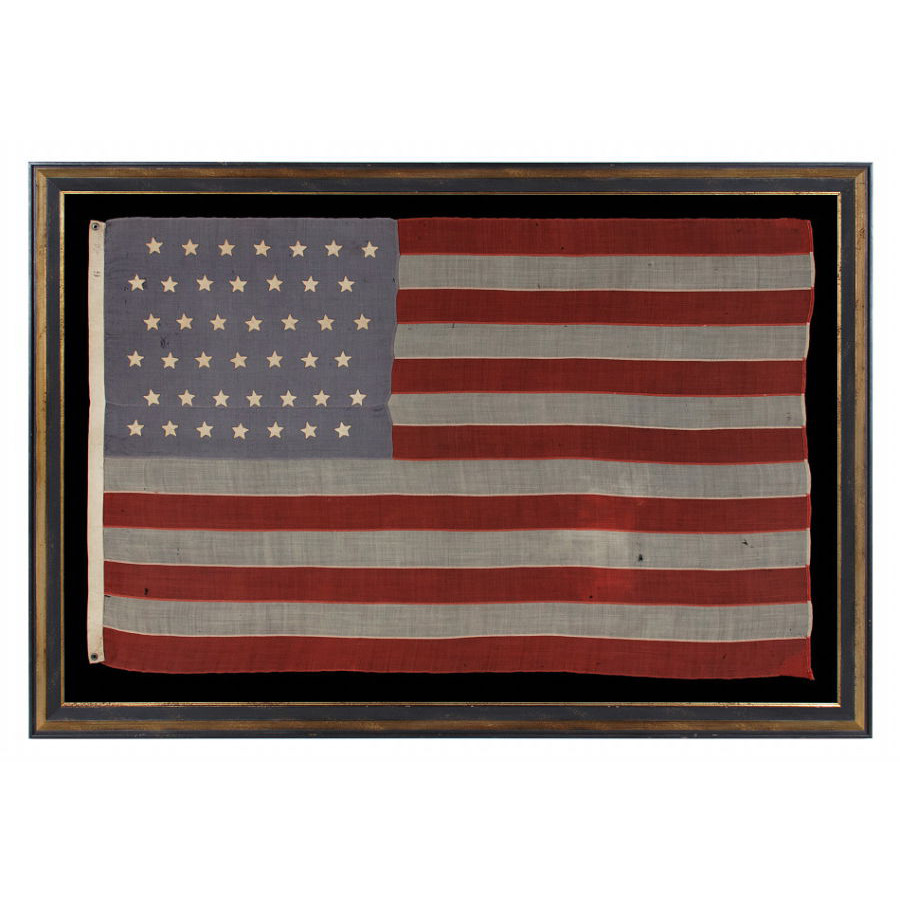
| |
42 HAND-SEWN STARS ON SMALL SCALE FLAG WITH A DUSTY BLUE CANTON, AN UNOFFICIAL STAR COUNT, WASHINGTON STATEHOOD, 1889-1890 |
|
| Available: |
Sold |
| Frame Size (H x L): |
57.5" x 83" |
| Flag Size (H x L): |
45.5" x 72" |
|
| Description....: |
|
42 star American national flag of the late 19th century, in a very small size for the period, with hand-sewn stars and attractive coloration.
The 42 star flag is interesting from a historical perspective, both because 42 was never an official star count, and because 42 star flags were only produced for about 8 months (November, 1889 – July 4th, 1890). The flag represents the addition of the Dakotas, Montana and Washington, between November 2nd and November 11th, 1889. The 42nd state was officially Washington, but the four states gained their statehood only nine days apart, and flag makers added four stars, accordingly, to the 38 star flag that was previously official.
After 1818, star counts became official on the 4th of July each year. A new star was therefore officially added on Independence Day for every state that had been added over the preceding “flag year”. Flag makers, however, did not wait for Independence Day and “official” star counts. Flag making was a competitive industry, and no one wanted to be making 38 star flags, for example, when their competitors were making 42 star flags and there were 42 states. On many occasions, particularly in the last quarter of the 19th century and the first decade of the 20th century, flag-makers would speculate the number of states that were going to be added and add the stars before they were official. It was for this precise reason that 42 was never an official star count. Idaho received statehood on July 3rd, 1890, taking the star count to 43 just one day before 42 would have become the official number. This fact makes 42 star flags an interesting part of our heritage and a classic display of American capitalism.
The stars of the flag are arranged in staggered rows, each of which contains 7 stars. These are made of cotton, hand-sewn, and double-appliquéd (applied to both sides). The stars are appliquéd with blue thread, which is unusual, accentuates the handwork, and gives them an earlier appearance that is especially appealing.
The canton and stripes of the flag are made of wool bunting that has been pieced with treadle stitching. There is a twill cotton binding along the hoist end with 2 brass grommets. The numeral "6" is stenciled near the top of the hoist on the obverse side in black ink to notate the size is 6 feet. "S." is hand-written after this, followed by at least one more character. These are likely the initials of a former owner. It was typical to mark flags in this manner during the 19th and early 20th centuries.
Note how the coloration of the canton has faded to a dusty blue-grey. When this trait is found in this particular weave of blue bunting, it is most often in flags that date between 1885 and 1895, and more often in the second half of that ten-year date bracket. After 1895, either flag manufacturers caught on to the fugitive dye and ordered different wool, or the textile company that was producing it changed its dying process. In any event, flags that were made with this wool and have survived to the present have an interesting presentation that many collectors find attractive.
In the 19th century, flags with sewn construction (as opposed to printed) were typically eight feet long or larger. Because flags needed to be seen and recognized from a great distance, large size important to their function as signals. A length of six feet on the fly was considered small and production of flags smaller than this was extremely limited. Because the average 19th century sewn flag can be cumbersome to frame and display in an indoor setting, many collectors prefer printed parade flags, which were far smaller on average, and small-scale sewn flags, like this one.
Mounting: The flag has been hand-stitched to 100% cotton for support on every seam and throughout the star field. It was then hand-stitched to 100% cotton twill, black in color, which will be washed to remove excess dye. An acid-free agent will be added to the wash to further set the dye and the fabric will be heat-treated for the same purpose. The mount was then placed over archival materials on a wooden strainer for support. The mount will then be placed in a black-painted, hand-gilded and distressed Italian molding. The glazing is U.V. protective acrylic.
Condition: In addition to the fading in the canton, there is very minor foxing and staining. There is minor fabric loss from expected wear at the top and bottom corners of the fly end, and a slight separation with associated loss in the top hoist end corner of the canton, where it meets the binding, accompanied by minor mothing throughout. Fabric of similar coloration was placed behind the flag in limited areas for masking purposes. There is a slightly bleached area in the lower fly-end corner of the stripe field, toward the center of the flag. Many of my clients prefer early flags to show their age and history of use. |
|
|
|
| Collector Level: |
Intermediate-Level Collectors and Special Gifts |
|
| Flag Type: |
Sewn flag |
|
| Star Count: |
42 |
|
| Earliest Date of Origin: |
1889 |
|
| Latest Date of Origin: |
1890 |
|
| State/Affiliation: |
Washington |
|
| War Association: |
1866-1890 Indian Wars |
|
| Price: |
SOLD |
|
| |
Views: 2426 |
|
|
|

